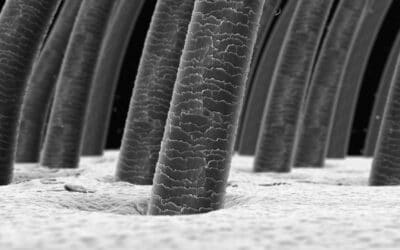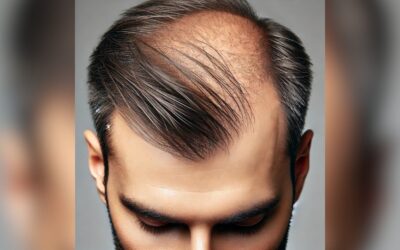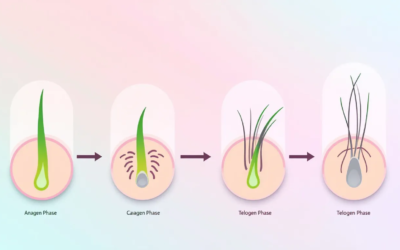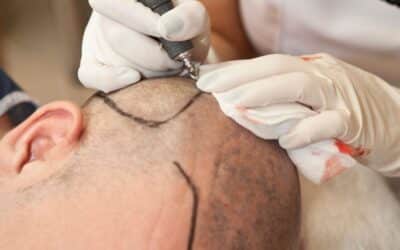A hair transplant is done when a person has lost hair due to genetic factors, aging, or other medical conditions. It involves the surgical relocation of healthy donor follicles from one area of the scalp to another. Hair transplants are becoming increasingly popular as they offer permanent solutions for baldness and thinning hair.
But before you decide on having a hair transplant procedure, it’s important you understand what is involved in each type. These include the Follicular Unit Transplant (FUT) and Follicular Unit Extraction (FUE). Explore these two techniques in-depth to help you determine which approach best fits your needs and lifestyle, as well as supply info on how to look after the results. So if you’re looking into understanding how a hair transplant is done, read on.
Table of Contents:
- What is a Hair Transplant?
- Follicular Unit Transplant (FUT)
- Follicular Unit Extraction (FUE)
- Aftercare for Hair Transplants
- FAQs in Relation to How Hair Transplant is Done
- Conclusion
What is a Hair Transplant?
A hair transplant is a surgical procedure that moves individual hair follicles from a donor area to bald or thinning areas. It’s used to treat male pattern baldness, female pattern baldness, and other forms of hair loss. Healthy follicles can be taken from the back and sides of the scalp (donor sites) and then implanted into areas with little to no hair growth (recipient sites), a process commonly employed in hair transplantation.
A hair transplant is a technique where strands of healthy follicles are extracted from one area and implanted into another region that may be thinning or balding. This process may restore lost density due to age, genetics, trauma, alopecia areata, chemotherapy treatments, etc. This results in fuller-looking natural results.
The Biggest Benefits of Hair Transplants
Gaining back self-confidence due to a fuller head of hair, reducing the appearance of thinning, and avoiding further damage caused by traction alopecia are just some of the advantages associated with undergoing a hair transplant procedure.
Furthermore, this method offers more long-lasting results than those achieved through topical medications like Rogaine, allowing individuals to style their tresses into braids or ponytails without fear of breakage. All in all, having thicker locks can make an immense difference in one’s quality of life. They will feel more attractive both physically and emotionally.
Hair restoration via Follicular Unit Transplant (FUT) is a viable solution for those seeking to permanently bring back their locks.
Follicular Unit Transplant (FUT)
Follicular Unit Transplant (FUT) is a surgical hair restoration procedure used to treat male and female pattern baldness. It involves harvesting healthy donor hair from the back or sides of the scalp and transplanting it into areas of thinning or balding on the head. FUT is considered one of the most effective treatments for permanent hair loss, with results lasting up to 10 years.
Overview of FUT Procedure:
During a FUT procedure, we remove a strip of skin containing healthy follicles from either side or back of the scalp. We stitch the donor area closed with sutures and left to heal. Next, we remove individual follicular units from this strip under high-powered microscope. Once we extract the follicular units, we implant the grafts into areas affected by hair loss.
Using specialized tools, our surgeon will carefully separate each individual follicular unit from its surrounding tissue before proceeding to implant the grafts into tiny incisions created at predetermined sites in recipient areas. To ensure proper healing and avoid any visible scarring, these incisions must then be closed with sutures and adhesive strips. The procedure necessitates great precision and accuracy for the best outcome.
Follicular Unit Transplant (FUT) is a popular hair transplant procedure that has helped many people restore their natural-looking hair. Moving on, Follicular Unit Extraction (FUE) is another surgical method used to treat baldness and thinning of the scalp.
Follicular Unit Extraction (FUE)
FUE is a minimally invasive hair transplant technique that extracts individual follicular units from the donor area with no incisions or sutures and local anesthesia. This method does not require any incisions or sutures and can be performed with local anesthesia. The process begins by harvesting follicles from the back and sides of the scalp, which are then transplanted into balding areas in a precise pattern to achieve natural-looking results.
Step-by-Step Guide to FUE Procedure:
During an FUE procedure, a small punch tool extracts individual follicles from the donor area one at a time. Once extracted, each follicle is placed into its own recipient site on the patient’s scalp. The placement of these grafts must be done carefully and strategically in order to ensure optimal growth and aesthetic results. Once the grafts have been inserted, a period of healing is required prior to any new hair growth appearing.
One advantage of this type of hair restoration surgery is that it leaves no linear scarring as seen with other methods such as strip harvesting or flap surgeries. It also allows for more precision when creating natural-looking hairlines. After all, each graft can be individually placed according to specific needs or preferences. On the downside, FUE procedures tend to take longer than other techniques due to their labor-intensive nature. However, modern advancements have made them much faster than they once were. Additionally, patients may experience some minor discomfort during recovery due to swelling or redness. This should subside within a few days after treatment.
Follicular Unit Extraction (FUE) is a safe and effective hair restoration procedure that can help to restore natural-looking, permanent results. Now let’s look at the aftercare required for successful hair transplants.
Aftercare for Hair Transplants
To ensure a successful hair transplant, postoperative care is critical to protect the newly transplanted follicles and promote their growth. Proper postoperative care is essential to ensure that your new hair follicles are not damaged and that they grow properly. To ensure optimal results, it is important to follow the recommended post-operative care instructions for your hair transplant.
Tips for Postoperative Care:
It’s important to follow all instructions given by your doctor regarding medications, diet, exercise, and other activities. In the initial days after your procedure, it is advisable to steer clear of any strenuous activities or lifting heavy objects. You should also avoid swimming and sunbathing until you have healed completely. Additionally, you may need to wear a special headband or cap while sleeping at night for several weeks after surgery in order to protect the grafts from rubbing against anything else while you sleep.
Common Side Effects and Complications:
After having a hair transplant procedure there may be some swelling around the scalp area which can last up to two weeks after surgery. This is normal and should subside over time with proper rest and medication if needed. In addition, there may be itching or redness near the donor site where hairs were harvested from. Again these side effects should go away over time with proper care such as avoiding scratching or using harsh soaps on the area when washing your hair.
FAQs in Relation to How Hair Transplant is Done
How is a hair transplant performed?
Hair transplantation is a lasting answer for hair loss, involving the relocation of strong follicles from an area on the scalp with more hair to those that are balding or thinning. The procedure is typically performed under local anesthesia, with small incisions made in both the donor and recipient sites. Once implanted, these grafts will grow naturally as if they were part of your original scalp. With proper care, you can expect to see results within 6-9 months after surgery.
How realistic is a hair transplant?
Hair transplants and hair restoration procedures are real solutions for those experiencing hair loss. When performed by an experienced, qualified professional with the latest techniques. These treatments can provide permanent results that look natural and healthy. For optimal results, the success of a treatment is largely contingent upon various factors such as individual health, age, scalp condition, and lifestyle habits. However, in most cases, expect a successful outcome.
Which hair transplant technique is most effective?
The most effective hair transplant technique is Follicular Unit Extraction (FUE). This procedure involves extracting individual follicles from the donor area of the scalp and then carefully implanting them into areas where there is baldness or thinning. It offers a permanent solution to hair loss with minimal scarring, no linear incision, and a fast recovery time. The results are natural-looking and can last for many years if properly cared for. FUE is the most advanced hair transplant technique available and provides the best outcome for those looking to restore their hair.
Can you use pubes for a hair transplant?
No respectable surgeon uses pubes for a hair transplant. Hair transplant procedures involve taking healthy donor hairs from the back and sides of the scalp and grafting them to areas with thinning or balding hair. Pubic hairs are too coarse in texture and not suitable for use as a donor source for hair transplants. Additionally, pubic hairs have a different growth cycle than head hairs which can lead to poor results when using them in transplantation surgeries.
Conclusion
After a hair transplant, follow the aftercare instructions from your doctor. Adhering to the aftercare instructions from your doctor is key for attaining optimal results and having a full head of lush, healthy-looking hair that will last. The success rate for these procedures is very high when proper care is taken. So don’t forget about taking good care of yourself following any type of hair transplant procedure.
Take the first step towards restoring your hair with a professional hair transplant procedure. Our team of experts is here to guide you through every stage, from initial consultation to post-operative care and beyond.
Best Hair Transplant
1970 S. Prospect Ave., Suite 2
Redondo Beach, CA 90277
(213) 403-0455
https://www.google.com/maps?cid=9280610872186794918










